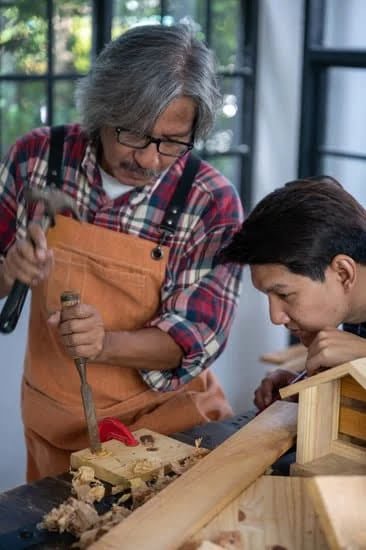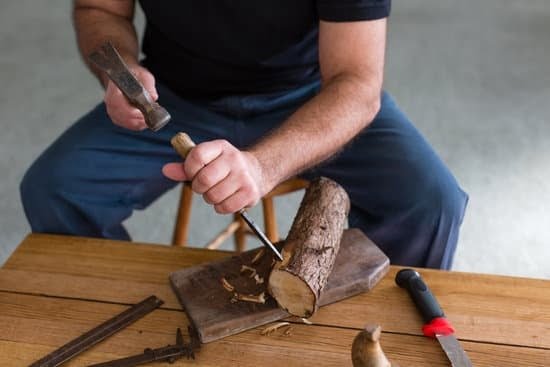Woodworking is a versatile and fulfilling craft that requires a wide range of tools to achieve professional results. From hand tools to power tools, specialty equipment to measuring and marking tools, every woodworker needs a well-rounded toolkit to tackle projects of all sizes.
In this article, we will explore the essential tools that every woodworker should have in their arsenal, from the basics to advanced techniques. Whether you are a beginner or an experienced woodworker looking to expand your collection, this guide will provide you with the knowledge and insight needed to build and maintain your woodworking toolkit.
The first section of this article will delve into the understanding of basic hand tools that all woodworkers should have. Chisels, hand planes, mallets, and coping saws are indispensable for cutting, shaping, carving, smoothing, and executing intricate designs on wood surfaces. These precision hand tools allow woodworkers to develop their skills in craftsmanship and create flawless woodworking projects.
Moving on to power tools, we will discuss must-have machines that can take your woodworking mastery to the next level. Circular saws, table saws, routers, and power drills are essential for making accurate cuts, joining pieces together securely with screws and bolts, creating decorative edges and patterns as well as obtaining precise measurements during woodworking projects.
For those who have mastered the basics and crave more advanced techniques in their woodworking endeavors will appreciate our exploration into specialty tools such as dovetail saws for crafting precise dovetail joints; Japanese pull saws for fine woodworking; scroll saws for detailed cuts; and spokeshaves for shaping rounded wooden surfaces.
Safety should always be at the forefront when working with any kind of tool. We will cover essential safety equipment including safety glasses for eye protection from flying debris; dust masks/respirators for filtering harmful dust particles; ear protection against loud noise generated by power tools; clamps used for securing workpieces safely during various stages of woodworking tasks.
In the following sections, we will dive into other aspects of woodworking such as the use of jigs and fixtures to ensure accuracy and repeatability; the importance of measuring and marking tools for precise measurements and markings; and maintaining and sharpening your woodworking tools to optimize their performance.
Understanding the Basics
Chisels
Chisels are undoubtedly a woodworker’s best friend when it comes to cutting, shaping, and carving wood. They come in various sizes and shapes, allowing for both rough and fine work. A beveled edge on one side of the chisel helps in creating clean cuts, while a flat backside provides stability and control.
When selecting chisels, it is crucial to choose high-quality ones made from hardened steel. A set of chisels with different widths will provide versatility for various woodworking projects. Maintaining the sharpness of the chisel blades is essential for precise cutting. Regular honing with sharpening stones or using a honing guide will ensure that your chisels are always ready for use.
Hand Planes
Hand planes are precision tools that every woodworker should have in their toolkit. These tools are used for smoothing and flattening wooden surfaces, ensuring a professional finish. The blade of a hand plane is positioned at an angle to the sole of the plane, allowing it to remove thin shavings of wood as it glides along the surface.
To achieve satisfying results with hand planes, it is essential to adjust them properly. Ensuring that the blade is sharp and properly aligned with the sole will allow for smooth planing action without tear-out or excessive resistance. Investing in a range of hand planes with different sizes and blade configurations will provide versatility for different woodworking tasks.
Mallets
Mallets are indispensable tools for woodworkers when it comes to driving chisels into wood or adjusting joints during assembly. Unlike hammers that can cause damage or dent softwood, mallets have larger heads made from softer materials like rubber or polyurethane. This ensures that force is evenly distributed without damaging delicate workpieces.
When selecting a mallet, consider its weight and balance. A well-balanced mallet will provide better control during striking, resulting in more accurate and controlled woodworking. Furthermore, having different sizes of mallets allows for versatility in various woodworking tasks, from delicate chisel work to heavy-duty joinery.
Coping Saw
The coping saw is a versatile tool that every woodworker needs when it comes to intricate cuts and curved designs. It features a narrow blade stretched tightly between the two ends of the frame, allowing for precise cutting in tight spaces or irregular shapes. Coping saw blades can easily be replaced when they become dull or worn out.
When using a coping saw, it is crucial to maintain proper tension on the blade. A loose blade will result in inaccurate cuts and excessive flexing, while an overly tight blade may lead to breakage. Additionally, selecting the appropriate tooth count for the blade will ensure optimal cutting performance for different types of wood and cuts.
Understanding how to use these essential hand tools properly is crucial for every woodworker’s success. With practice and experience, artisans can harness the full potential of these tools to create masterful pieces of woodworking art.
Must-Have Power Tools for Woodworking Mastery
Circular Saw: Versatile and Efficient
The circular saw is a must-have power tool for any woodworker. With its ability to make straight cuts, bevels, and rips, it offers versatility in woodworking projects. Whether you need to cut plywood, boards, or veneer, a circular saw can get the job done quickly and efficiently. It’s also portable, making it great for on-site projects or work in a small workshop.
Table Saw: The Backbone of Woodworking Shops
Considered the backbone of woodworking shops, a table saw is an essential tool for making long and precise cuts. With its large cutting surface and adjustable blade height and angle, it allows woodworkers to create clean edges and accurate miters. Table saws can handle a wide range of materials from solid wood to plywood, making them indispensable for many woodworking projects.
Router: Creating Decorative Edges and Complex Patterns
A router is another crucial power tool that every woodworker should have. This versatile tool allows users to create decorative edges, intricate joinery, and complex patterns on wooden surfaces. With the right set of bits, a router can transform plain boards into beautifully crafted pieces. It can also be used for hollowing out grooves or creating raised panel doors.
Power Drill: Making Holes and Securing Fasteners
No woodworking toolkit is complete without a power drill. From making holes of various sizes to securing screws and bolts, a power drill is the go-to tool for many woodworking tasks. Choose a cordless drill with adjustable speed settings for added versatility. Look for one with comfortable grip handles to ensure precision and control while working.
Having these must-have power tools in your woodworking arsenal will greatly enhance your capabilities as a woodworker. They will provide efficiency, accuracy, and versatility in completing your projects. Remember to always follow safety precautions and read the user manuals for each tool to ensure proper usage and maintenance.
Specialty Tools for Advanced Woodworking Techniques
Advanced woodworking techniques require specialized tools that can offer precision, accuracy, and intricate detailing. These specialty tools elevate the craftsmanship of woodworkers and allow them to push their creative boundaries. Here are some must-have specialty tools for advanced woodworking techniques:
- Dovetail Saw: A dovetail saw is specifically designed for crafting dovetail joints with precision. This saw has a thin blade with fine teeth, allowing woodworkers to make clean and accurate cuts for strong and visually appealing joints.
- Japanese Pull Saw: The Japanese pull saw is ideal for fine and intricate woodworking tasks. It has a unique design where the blade is pulled toward the user rather than pushed away, resulting in greater control and accuracy when making delicate cuts.
- Scroll Saw: A scroll saw is an essential tool for detailed and delicate cuts, intricate patterns, and curves. It features a small thin blade that moves up and down rapidly, allowing woodworkers to create intricate designs with ease.
- Spokeshave: Used for shaping and smoothing rounded wooden surfaces, a spokeshave is a versatile tool that can create precise curves and contours. It consists of a narrow blade with handles on either side, providing control over the amount of material being removed.
These specialty tools open up new possibilities for woodworking projects by enabling woodworkers to incorporate advanced techniques such as dovetail joinery, intricate designs, curved detailing, and smooth shaping. Investing in these tools can significantly enhance the quality of finished workpieces and provide endless opportunities for creativity.
| Tool | Description |
|---|---|
| Dovetail Saw | A saw designed specifically for crafting dovetail joints with precision. |
| Japanese Pull Saw | An ideal saw for fine and intricate woodworking tasks. |
| Scroll Saw | An essential tool for detailed and delicate cuts, intricate patterns, and curves. |
| Spokeshave | A tool used for shaping and smoothing rounded wooden surfaces. |
Safety First
Woodworking can be a fulfilling and enjoyable hobby, but it is important to prioritize safety when working with sharp tools and powerful machinery. The right equipment and protective gear can make all the difference in preventing accidents and ensuring a safe woodworking environment. Here are some essential items every woodworker should have:
- Safety Glasses: When working with wood, there is always a risk of flying wood chips and debris. Protecting your eyes with safety glasses is crucial to prevent eye injuries.
- Dust Masks/Respirators: Woodworking generates a significant amount of dust, which can be harmful to your respiratory system if inhaled. Wearing a dust mask or respirator is essential for filtering out wood dust particles and protecting your lungs.
- Ear Protection: Many power tools used in woodworking produce loud noise levels that can damage your hearing over time. Wearing ear protection, such as earmuffs or earplugs, will help minimize the risk of hearing loss or damage.
- Clamps: Clamps are necessary for securing workpieces during cutting, gluing, and assembly. They help prevent your hands from coming into contact with sharp blades or moving parts of machinery.
To ensure a safe woodworking environment, it is crucial to use these essential safety equipment and protective gear while working on any project. Remember that accidents can happen even to experienced woodworkers, so taking precautions is always important. By using safety glasses, dust masks/respirators, ear protection, and clamps, you can significantly reduce the risk of injuries while enjoying your woodworking projects.
Understanding Woodworking Jigs and Fixtures
Woodworking jigs and fixtures are invaluable tools that help woodworkers achieve more precise and efficient results. These tools serve as aids in performing specific tasks such as making accurate cuts, drilling precise holes, and securing workpieces during various woodworking processes. By understanding the different types of jigs and fixtures available, woodworkers can greatly enhance their craftsmanship and productivity.
One essential woodworking jig is the miter sled. This tool assists in making accurate and repeatable miter cuts, especially when working with long or wide boards. With a miter sled, woodworkers can ensure that their cuts are perfectly square and eliminate any errors caused by human error or uneven materials.
Another important jig is the dowel jig. This tool is used for precise drilling and alignment of dowel holes, which play a crucial role in creating strong joints between pieces of wood. Dowel jigs allow woodworkers to drill consistent holes at the correct angles, resulting in tight-fitting dowels that ensure strong and durable connections.
For those who prefer using screws for joinery, a pocket hole jig is an indispensable tool. This jig enables woodworkers to create strong and invisible joints using screws by drilling pocket holes at the appropriate angles. Pocket hole jigs make it easier to assemble furniture pieces or projects involving multiple components quickly.
Featherboards are another type of fixture that every woodworker should have in their toolkit. These devices help secure workpieces firmly against a fence or table during cutting operations, preventing kickback and ensuring safer woodworking practices. Featherboards also provide support for workpieces, reducing the risk of any potential movement or shifting during cutting tasks.
By incorporating woodworking jigs and fixtures into their craft, woodworkers can elevate their precision levels, simplify complex tasks, and achieve professional-quality results consistently. These tools offer increased accuracy while providing additional convenience throughout various woodworking processes. As with any other tool category, it is essential to research and invest in high-quality jigs and fixtures that match specific woodworking needs.
Essential Measuring and Marking Tools
Measuring and marking are crucial aspects of woodworking that require precision and accuracy. Without the proper tools, it can be challenging to achieve the desired results. In this section, we will explore some essential measuring and marking tools that every woodworker should have in their toolkit.
One of the fundamental tools for any woodworker is a tape measure. It is essential for measuring lengths, widths, and heights accurately. A tape measure with both imperial and metric measurements is recommended to accommodate different project requirements.
Another versatile tool is the combination square. This tool is crucial for making precise measurements and markings. With its adjustable head, it can be used to measure angles, check squareness, establish reference edges, and make repetitive marks.
A carpenter’s pencil is specifically designed for making visible marks on wood surfaces. Unlike regular pencils, carpenter’s pencils have a thick lead that resists breaking or crumbling when marking on rougher surfaces.
Lastly, a marking gauge is an indispensable tool for creating accurate and consistent lines for joinery and cutting. It consists of a rod with a marking wheel or blade at one end. By adjusting the position of the rod, woodworkers can set the distance from the edge of their workpiece to mark parallel lines or distances.
| Tool | Function |
|---|---|
| Tape Measure | Measuring lengths, widths, and heights accurately |
| Combination Square | Making precise measurements and markings; checking angles and squareness |
| Carpenter’s Pencil | Making visible marks on wood surfaces |
| Marking Gauge | Creating accurate and consistent marking lines for joinery and cutting |
Having these essential measuring and marking tools in your woodworking toolkit will help you achieve precise and accurate results. Remember to use them with care and maintain their sharpness for optimal performance.
Maintaining and Sharpening Woodworking Tools
Woodworking tools, like any other tools, require regular maintenance and sharpening to ensure they work effectively and produce high-quality results. Without proper maintenance, tools can become dull, lose their accuracy, and even succumb to rust. In this section, we will explore the essential steps and tools needed to maintain and sharpen woodworking tools.
To keep your chisels, plane blades, and other cutting tools sharp, you will need sharpening stones. These come in various grits and are used to remove nicks and imperfections from the edges of your tools. Start with a coarse-grit stone to reshape the edge of the tool if necessary, then progress to finer grit stones for honing and polishing. A honing guide is also helpful for maintaining consistent and accurate sharpening angles.
In addition to regular sharpening, it is important to keep your woodworking tools well-lubricated. This helps prevent rust from forming on metal surfaces and ensures smooth operation. Tool lubricants such as specialized oils or wax can be applied periodically to protect against moisture and corrosion.
Lastly, having a suitable workbench for maintaining and sharpening your woodworking tools is crucial. A sturdy workbench provides a stable surface for securing your tools during sharpening processes. It should have a vise or clamps that securely hold the tool in place while you work on it.
By regularly maintaining and sharpening your woodworking tools, you can prolong their lifespan, enhance their performance, and achieve precise results in your woodworking projects. Taking the time to care for your tools will ultimately save you money in the long run by avoiding costly replacements or repairs.
- Sharpening Stones: Essential for keeping chisels, plane blades, and other tools sharp.
- Honing Guide: Ensures consistent and accurate sharpening angles.
- Tool Lubricants: Necessary for preventing rust and keeping tools in optimal condition.
- Workbench: Provides a sturdy and stable surface for sharpening and maintaining tools.
Conclusion
In conclusion, building a comprehensive and functional woodworking toolkit is essential for any woodworker, whether they are a beginner or an advanced craftsman. Throughout this article, we have explored the essential hand tools, power tools, specialty tools, safety equipment, measuring and marking tools, as well as maintenance and sharpening tools that are indispensable for woodworking projects.
It is important to remember that acquiring all these tools at once can be overwhelming and costly. Instead, it is advisable to start with the basics and gradually expand your collection as your skills advance and projects become more complex. Investing in high-quality tools will ensure longevity and efficiency in your work.
Researching various brands and reading reviews can also help you make informed decisions when selecting the right tools for your needs. Taking care of your tools through regular maintenance and sharpening will prolong their lifespan and keep them performing at their best.
Ultimately, building a woodworking toolkit is not only about having the necessary instruments but also about honing one’s skills through practice. With dedication, patience, and the right set of tools by your side, you can embark on countless woodworking projects with confidence and achieve remarkable results.
Frequently Asked Questions
Which tools do you need for woodworking?
Woodworking requires a variety of tools to complete different tasks. Some essential tools include a saw, such as a handsaw or a circular saw, which is crucial for cutting wood accurately. Another necessary tool is a chisel, used for carving and shaping wood.
A plane is also vital, as it helps in smoothing and flattening wooden surfaces. Additionally, having measuring and marking tools like a tape measure and a square are essential for accurate measurements and angles. Lastly, every woodworker needs a reliable set of clamps to hold pieces securely while working on them.
What is the most useful tool for woodworking?
While there are many useful tools in woodworking, one that stands out as particularly indispensable is the versatile router. The router allows woodworkers to shape and hollow out areas of wood with precision. It can create decorative edges, carve grooves, and perform intricate designs effortlessly.
Not only does it provide versatility in creative woodworking techniques but also saves time by efficiently removing material from the workpiece. The router truly enhances the quality and intricacy of woodworking projects.
What are 4 basic skills woodworkers should have?
Woodworkers should possess several basic skills to excel in their craft. First and foremost, understanding how to accurately measure materials is crucial; therefore, being proficient in using measuring tools like rulers or tape measures is vital for precise cuts and dimensions. Additionally, mastering the art of cutting wood precisely using hand saws or power saws will greatly impact the final product’s quality.
Next, skillfully working with chisels will allow for precise carving and shaping of wooden surfaces without damaging the material further than desired. Lastly, having good knowledge of sanding techniques ensures that wooden surfaces are smooth and free from imperfections before applying any finishes or treatments to the project piece.

Hi everyone! I’m a woodworker and blogger, and this is my woodworking blog. In my blog, I share tips and tricks for woodworkers of all skill levels, as well as project ideas that you can try yourself.





